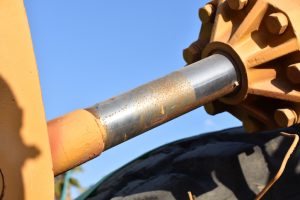
We pride ourselves on being “The Seal Specialist”, and our engineering department is ready to help seal your toughest application. But where do you even start? Keep reading to learn more about some of the fundamentals of seal design and fluid power sealing theory from our partners at Parker.
"Every seal, whether static or dynamic, must seal against at least two contacting surfaces," Parker says in its Fluid Power Seal Design Guide. "In static applications, both surfaces are non-moving relative to one another."
When it comes to dynamic applications, at least one surface is in motion relative other sealing surfaces. For example, the rod and piston seals in a standard hydraulic cylinder would be considered dynamic seals, while the seal between the head gland and bore would be classified as a a static seal.
A certain amount of compression or squeeze is needed in both types of applications upon installation, in order to prevent fluids from leaking and to maintain contact with the sealing surfaces.
This is especially true for dynamic applications, as they involve other variables and require the evaluation of additional factors to ensure the correct system performance.
Leakage Control
Any discussion of fluid power sealing theory needs to include leakage control.
Controlling leaks is the ultimate goal when choosing a sealing system. Improvements in seal design and material have made it possible to have seal combinations that provide zero leakage along with extended life in a number of applications.
"Aside from the seals themselves, a thorough understanding of system parameters is necessary to obtain the best results," Parker says. "Optimal sealing is best achieved by taking a systems approach to the seal package rather than considering components individually. Our profiles have been designed specifically to complement one another to create high performance systems."
For example, when a rod seal and a wiper are paired together, it maximizes contamination exclusion while minimizing fluid leakage.
The rod seals are designed with knife-trimmed lips to ensure the best possible film breaking. This dry rod technology allows for an aggressive wiper, excluding contamination while avoiding built-up oil leakage around the wiper.
Another leakage control method is the use of multiple sealing lips. A buffer ring, u-cup and a double-lip canned wiper are designed to function in tandem, giving optimized performance and the driest sealing in the industry.
But remember that leakage is still possible even when the correct seals are specified. This is due to factors beyond the seals themselves, such as surface finish and installation damage, storage, chemical wash downs, maintenance and contamination.
You will have the best chance of minimizing leakage by adhering to design recommendations for seals and mating hardware.
Lip vs. Squeeze Seals
We'll conclude our discussion of fluid power sealing theory by looking at the difference between lip and squeeze seals.
"The cross sectional shape of a seal dramatically affects how it functions, especially at low pressure," Parker says in its guide. "The greatest trade-off in dynamic sealing is low friction performance vs. low pressure sealability."
The difference between lip and squeeze seals can affect things like friction, wear and sealing ability in low pressure situations.
That's why seals are often labeled either "lip" or "squeeze." Lip seals are characterized by low wear and friction, but generate poor low pressure sealability. Squeeze seals are the opposite: high wear and friction, but offering better low pressure sealability.
A squeeze seal will generate considerably more sealing force than a lip seal, assuming both seals are under little to no pressure.
But as pressure rises, the differences between the two seal types become negligible because of the force from the fluid pressure overcoming the designed squeeze.
Pressure typically improves leakage control, but also increases friction, heat, wear and the potential for extrusion.
When dealing with pneumatic applications, it's crucial to keep friction low, which is why lip seals are an excellent choice for low pressure applications.
On the other end of the scale, squeeze seals are an appropriate choice for hydraulic cylinders, where high system pressure can easily overwhelm frictional forces.
An example of this sort of application is a gravity-returned hydraulic ram. In this situation, a lip hydraulic seal would generate less friction and allow the gravity return to function properly.
To learn more about which seal is necessary for your application, please contact Gallagher Fluid Seals.
